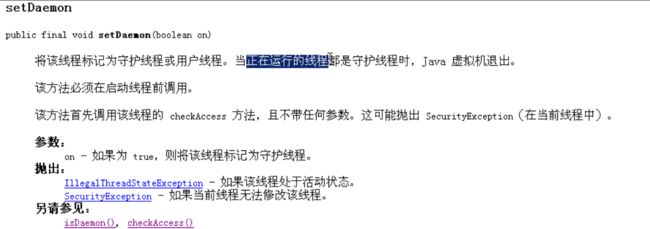JAVA之旅(十五)——多线程的生产者和消费者,停止线程,守护线程,线程的优先级,setPriority设置优先级,yield临时停止
JAVA之旅(十五)——多线程的生产者和消费者,停止线程,守护线程,线程的优先级,setPriority设置优先级,yield临时停止
我们接着多线程讲
一.生产者和消费者
什么是生产者和消费者?我们解释过来应该是生产一个,消费一个,的意思,具体我们通过例子来说
package com.lgl.hellojava;
//公共的 类 类名
public class HelloJJAVA {
public static void main(String[] args) {
/** * 生产者和消费者 */
Resrource res = new Resrource();
Produce pro = new Produce(res);
Consumer con = new Consumer(res);
Thread t1 = new Thread(pro);
Thread t2 = new Thread(con);
t1.start();
t2.start();
}
}
// 资源
class Resrource {
private String name;
private int count = 1;
private boolean flag = false;
// 生产
public synchronized void set(String name) {
if (flag) {
try {
wait();
} catch (InterruptedException e) {
// TODO Auto-generated catch block
e.printStackTrace();
}
// 每次设置添加编号
this.name = name + "-" + count++;
System.out.println(Thread.currentThread().getName() + "--生产者--"
+ this.name);
flag = true;
this.notify();
}
}
// 消费
public synchronized void out() {
if (!flag)
try {
wait();
} catch (InterruptedException e) {
// TODO Auto-generated catch block
e.printStackTrace();
}
System.out.println(Thread.currentThread().getName() + "--消费者--"
+ this.name);
flag = false;
this.notify();
}
}
// 生产
class Produce implements Runnable {
private Resrource res;
public Produce(Resrource res) {
this.res = res;
}
@Override
public void run() {
while (true) {
System.out.println("Android");
}
}
}
// 消费
class Consumer implements Runnable {
private Resrource res;
public Consumer(Resrource res) {
this.res = res;
}
@Override
public void run() {
while (true) {
res.out();
}
}
}当我们生产一个,消费一个,就具有多线程的特性,如果出现其他现象,那就说明你的线程存在安全隐患了
二.停止线程
怎么让线程停?你会想到stop方法
既然已过时,我们就的去想其他办法了,跟其原理,是什么?run方法结束就是线程停止,那怎么让run方法结束?
- 只要控制循环,就可以让run方法结束,也就是线程的结束
我们写个实例
package com.lgl.hellojava;
import org.omg.CORBA.FloatHolder;
//公共的 类 类名
public class HelloJJAVA {
public static void main(String[] args) {
/** * 线程停止 */
stopThread s = new stopThread();
Thread t1 = new Thread(s);
Thread t2 = new Thread(s);
t1.start();
t2.start();
int num = 0;
while (true) {
if (num++ == 60) {
s.changeFlag();
break;
} else {
System.out.println(Thread.currentThread().getName()
+ "Main run");
}
}
}
}
class stopThread implements Runnable {
private boolean flag = true;
@Override
public void run() {
while (flag) {
System.out.println(Thread.currentThread().getName() + "Thread run");
}
}
public void changeFlag() {
flag = false;
}
}
逻辑十分简单,只要达到要求,就停止,但是还有一种特殊情况,当线程处于冻结状态,就不会读取到标记,那线程就不会结束,我们看
package com.lgl.hellojava;
import org.omg.CORBA.FloatHolder;
//公共的 类 类名
public class HelloJJAVA {
public static void main(String[] args) {
/** * 线程停止 */
stopThread s = new stopThread();
Thread t1 = new Thread(s);
Thread t2 = new Thread(s);
t1.start();
t2.start();
int num = 0;
while (true) {
if (num++ == 60) {
s.changeFlag();
break;
} else {
System.out.println(Thread.currentThread().getName()
+ "Main run");
}
}
}
}
class stopThread implements Runnable {
private boolean flag = true;
@Override
public synchronized void run() {
while (flag) {
try {
wait();
} catch (InterruptedException e) {
System.out.println(Thread.currentThread().getName()
+ "InterruptedException run");
}
System.out.println(Thread.currentThread().getName() + "Thread run");
}
}
public void changeFlag() {
flag = false;
}
}
这样就循环了。而在我们多线程中,提供了一个中断的方法Interupted
三.守护线程
守护线程其实也是Interupted中的东西,我们来看
你只要在启动线程前调用就可以了,就标记成了守护线程,就是一个依赖关系,你在我在,你不在我也不在;
四.Join方法
这个也是一个方法,意思是等待线程终止
我们倒是可以写个小例子
package com.lgl.hellojava;
//公共的 类 类名
public class HelloJJAVA {
public static void main(String[] args) {
/** * Join */
Demo d = new Demo();
Thread t1 = new Thread(d);
Thread t2 = new Thread(d);
t1.start();
try {
// t1要申请加入到运行中来
t1.join();
} catch (InterruptedException e) {
// TODO Auto-generated catch block
e.printStackTrace();
}
t2.start();
for (int i = 0; i < 100; i++) {
System.out.println("miam" + i);
}
System.out.println("main over");
}
}
class Demo implements Runnable {
@Override
public void run() {
for (int i = 0; i < 100; i++) {
System.out.println(Thread.currentThread().getName() + "=---" + i);
}
}
}
我们可以满足条件下 ,临时加入一个线程
当A线程执行到了B线程的join方法时,A线程就会等待,等B线程都执行完,A才会执行,A可以用来临时加入线程执行。
五.线程的优先级
线程有优先级,默认的优先级都是5,这个是可以改变的,t1.setPriority(优先级);
我们可以拿上面的例子来做个比较
package com.lgl.hellojava;
//公共的 类 类名
public class HelloJJAVA {
public static void main(String[] args) {
/** * Join */
Demo d = new Demo();
Thread t1 = new Thread(d);
Thread t2 = new Thread(d);
t1.start();
//权限虽然高,只是频率高而已
t1.setPriority(Thread.MAX_PRIORITY);
t2.start();
for (int i = 0; i < 100; i++) {
System.out.println("miam" + i);
}
System.out.println("main over");
}
}
class Demo implements Runnable {
@Override
public void run() {
for (int i = 0; i < 100; i++) {
System.out.println(Thread.currentThread().getName() + "=---" + i);
}
}
}
我们这里还有一个小方法yield,临时停止的意思,我们可以看例子
package com.lgl.hellojava;
//公共的 类 类名
public class HelloJJAVA {
public static void main(String[] args) {
/** * Join */
Demo d = new Demo();
Thread t1 = new Thread(d);
Thread t2 = new Thread(d);
t1.start();
t2.start();
for (int i = 0; i < 100; i++) {
// System.out.println("miam" + i);
}
System.out.println("main over");
}
}
class Demo implements Runnable {
@Override
public void run() {
for (int i = 0; i < 100; i++) {
System.out.println(Thread.currentThread().getName() + "=---" + i);
Thread.yield();
}
}
}
我们可以看到
主线程并没有运行,那就对了,因为暂停了
我们到这里,本篇就结束了,同时线程所讲的知识也讲完了,线程博大精深,很值得我们学习,我所讲的,仍然只是一些皮毛罢了,希望大家多用心研究一下



